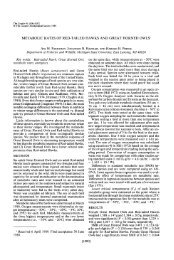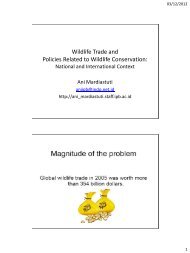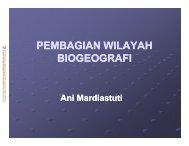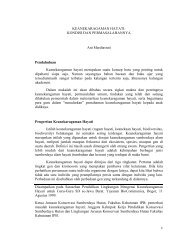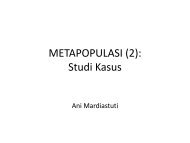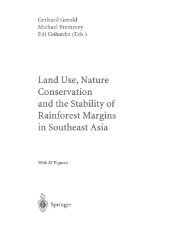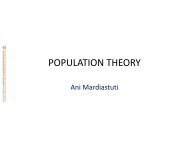BIOGEOGRAPHY OF INDONESIA
BIOGEOGRAPHY OF INDONESIA
BIOGEOGRAPHY OF INDONESIA
Create successful ePaper yourself
Turn your PDF publications into a flip-book with our unique Google optimized e-Paper software.
27/11/2011<br />
<strong>BIOGEOGRAPHY</strong><br />
<strong>OF</strong> <strong>INDONESIA</strong><br />
Ani Mardiastuti<br />
MESOZOIC ERA (200 million years ago)<br />
1
27/11/2011<br />
Distribution of Ratites<br />
Distance does not matter<br />
2
27/11/2011<br />
CONTINENTAL DRIFT AND ANIMAL<br />
DISTRIBUTION<br />
Biogeographic Regions<br />
Sclater—Birds, Marine Mammals<br />
Wallace—Terrestrial Mammals<br />
Hooker—Plants<br />
3
27/11/2011<br />
The World‟s Zoogeographic Regions<br />
from Time to Time<br />
FATHER <strong>OF</strong> <strong>BIOGEOGRAPHY</strong><br />
Philip Lutley Sclater<br />
4
27/11/2011<br />
Zoogeographic Regions<br />
5
27/11/2011<br />
6
27/11/2011<br />
Zoogeographic Region<br />
1. Holarctic (Palearctic plus Nearctic)<br />
a. Palearctic<br />
Europe, North Africa (to Sahara), Asia (except India,<br />
Pakistan and SE Asia) and Middle East.<br />
Number of vertebrate families = 42; Endemics<br />
families = 0.<br />
b. Nearctic<br />
Canada, USA, Mexico to tropics<br />
Number of families = 37; endemics = 2.<br />
2. Neotropical<br />
Tropical Mexico south to South America, Antilles<br />
Number of families = 50; endemics = 19.<br />
7
27/11/2011<br />
3. Ethiopian<br />
Madagascar, Africa south of the Sahara, southern<br />
Arabian Peninsula<br />
Number of families = 52; endemics = 18.<br />
4. Oriental<br />
Pakistan, India, Southeast Asia, Philippines,<br />
Indonesia west of Wallace's line (Sumatra, Java,<br />
Borneo)<br />
Number of families = 50; endemics = 4.<br />
5. Australian<br />
6. Oceanic<br />
Australia, New Guinea, Tasmania, Indonesian<br />
Islands east of Wallace's line (Celebes, Timor, etc.)<br />
NOTE: does not include New Zealand<br />
Number of families = 28; endemics = 17.<br />
Oceans of the world and truly oceanic, isolated,<br />
small islands<br />
8
27/11/2011<br />
Alfred Russel Wallace<br />
9
27/11/2011<br />
10
27/11/2011<br />
Endemic Fauna of Sulawesi<br />
11
27/11/2011<br />
Zoogeographic Regions for Marine Species (based on marine mammals)<br />
12
27/11/2011<br />
Phytogeographic Regions of the World<br />
Floristic Regions (Good‟s)<br />
1. Boreal or Holarctic<br />
2. Neotropical<br />
3. Paleotropical<br />
4. Cape or South African<br />
5. Australian<br />
6. Antarctic<br />
13
27/11/2011<br />
Nikolai Vavilov's centers of origin:<br />
Southeast Asia - coconut, rice, sugarcane<br />
China - Chinese cabbages, soybean<br />
India - cucumbers, eggplant, pigeonpea<br />
Turkey-Iran - wheat, barley, oats, figs<br />
Mediterranean - almonds, cabbage, olives<br />
Mexico/Central America - maize, tomato<br />
Andes/Brazil/Paraguay - peppers, potato, rubber<br />
14
27/11/2011<br />
Global Climate Pattern<br />
Global Warming and Shift of Plant Distribution<br />
15
27/11/2011<br />
Biodiversity Hotspots<br />
(Conservation International)<br />
17 Wallaces’ Biogeographic Principles<br />
1. Distance alone does not determine degree of<br />
biogeographic affinity.<br />
2. Climate has strong, but not complete, effect on<br />
taxonomic similarity.<br />
3. Prerequisites for determining biogeographic patterns:<br />
detailed knowledge of distributions<br />
natural classification of organisms<br />
theory of evolution<br />
knowledge of extinct forms<br />
knowledge of historical geology<br />
4. Fossil record is positive record of past migrations.<br />
16
27/11/2011<br />
5. Present biota strongly influenced by last geological<br />
and climatic events.<br />
6. Competition, predation, etc. influence distribution,<br />
dispersal, extinction.<br />
7. Discontinuous ranges result (sometimes) from<br />
extinction or habitats mosaics.<br />
8. Species results from geographic isolation and local<br />
adaptation.<br />
9. Disjunctions of genera and higher taxa are older than<br />
those between species.<br />
10. Oceanic islands usually colonized through longdistance<br />
dispersal.<br />
11. Past land connections reflect current distributions of<br />
poor dispersers.<br />
12. Adaptive radiations can occur when predation<br />
and competition are reduced.<br />
13. Suturing formerly isolated biotas can lead to<br />
extinctions through competition.<br />
14. Current and historical processes can act at<br />
different intensities.<br />
15. Island biotas form according to island type (landbridge,<br />
oceanic).<br />
16. Patterns are simplified in island biotas, making<br />
them important model systems.<br />
17. To analyze the history of a regional biota:<br />
phylogenetic and distributional data.<br />
17
27/11/2011<br />
Human Influence on Original Species<br />
Distribution<br />
Human colonization<br />
Harvest flora and fauna<br />
Introduction of new species<br />
Reintroduction<br />
Human Colonization<br />
Competition with indigenous human /<br />
flora / fauna<br />
Impact :<br />
Failure of colonization<br />
Coexistence<br />
Extirpation of indigenous<br />
human/flora/fauna<br />
18
27/11/2011<br />
Cases<br />
Americans vs. First Nations (“Indian”)<br />
Australians vs. Aborigins<br />
Harvest of Flora and Fauna<br />
Related to human colonization<br />
Impact :<br />
<br />
<br />
<br />
Decrease or extinction of some species,<br />
esp. endemic species<br />
Habitat degradation<br />
Community change<br />
19
27/11/2011<br />
Cases : Extinction<br />
Passenger Pigeon<br />
20
27/11/2011<br />
Birds of Hawaii<br />
Human: the „intelligent‟ creature<br />
21
27/11/2011<br />
Animal Extinction Since 1600<br />
Taxon Island Continents<br />
Birds 97 20<br />
Molluscs 151 40<br />
Mammals 34 24<br />
Reptiles 22 1<br />
Amphibians 0 2<br />
Insects 51 10<br />
Total 355 97<br />
Habitat Degradation<br />
22
27/11/2011<br />
Community Change<br />
Introduction of New Species<br />
Sentimental reason<br />
‣ European Starling<br />
‣ Water hyacinth<br />
Production<br />
‣ Eucalyptus<br />
‣ Ostrich<br />
‣ Long-tailed Macaques<br />
Why introduce species ?<br />
‣ Various domesticated species<br />
“Control” of pest<br />
‣ Mongoose in Hawaii<br />
‣ Dingo in Australia<br />
23
27/11/2011<br />
Domesticated Plants & Animals<br />
Alien species around us<br />
24
27/11/2011<br />
Trends<br />
Floriculture species<br />
Horticulture<br />
Aquaria<br />
Agriculture<br />
Pets<br />
Sylviculture<br />
Estate crops<br />
Usually ok if<br />
NON-INVASIVE<br />
Global Problem :<br />
Invasive Alien Species<br />
Indigenous Species decrease or<br />
extinct<br />
Carp vs. trout in US rivers<br />
Cause problems to human<br />
Water hyacinth (eceng gondok),<br />
Keong emas<br />
25
27/11/2011<br />
Alien sp.<br />
Alien species sometimes lead to<br />
transmission of new disease and new<br />
pests<br />
Some diseases zoonosis<br />
26
27/11/2011<br />
Cases in Indonesia<br />
„Kutu loncat‟<br />
New Castle Disease<br />
Avian influenza (Flu burung)<br />
Anthrax<br />
Reintroduction<br />
Try to “fix” ecosystem<br />
Case:<br />
‣ Bali Starling in Bali<br />
‣ Rote Island Snake-necked Turtle<br />
27





